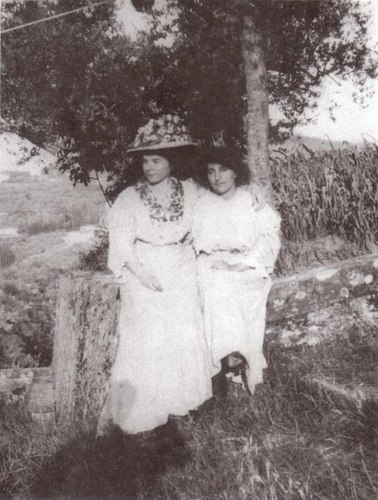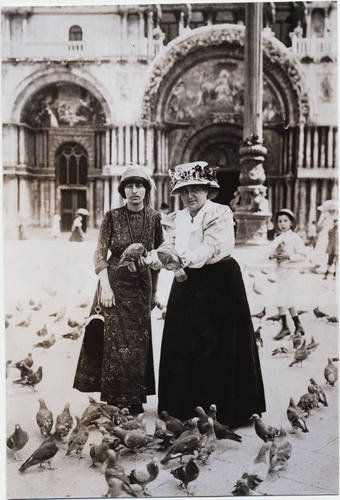August 22 ハリエットとアリスとガートルード――昔のサンフランシスコのユダヤ人の少女時代 (2)、またはパリのアメリカ娘たち Harriet, Alice, and Gertrude: A Jewish Girlhood in Old San Francisco (2); or, American Girls in Paris [本・読み物 reading books]
August 22, 2008 (Friday)
August 19 昔のサンフランシスコのユダヤ人の少女時代 (1) A Jewish Girlhood in Old San Francisco
の続きです。
Harriet Lane Levy (1867 - 1950)
Alice B. Toklas (1877 - 1967)
Gertrude Stein (1874 - 1946)
hag という並びに意味はありません。Gertrude Stein は美術の教科書にピカソによる肖像画が載っていたり、あるいは第一次大戦後にErnest Hemingway とか the lost generation の名付け親になったりして、おばちゃんというイメジが強いですが、パリに渡ったのは20代のときでした。そのスタインのいるパリへ、前述のように、スタインの義姉のSarah がオファレルのご近所出身だったという縁で、Harriet Levy とAlice B. Toklas は1907年9月、それぞれ30代の終わりと20代の終わりに、やってきて、expatriate 国籍離脱型の生活を始めます。
1907年9月8日、パリに着いたその日にアリスを連れてスタインたちを訪問します。 と前回書いて、とまったのはウィキペディアの記事にひっかかったからでした。で、ちょっとWikipedia を題材に英語の勉強をすることにしましたw
いま自分の記事を読み直すと、 「日本語版ウィキペディアの「ガートルード・スタイン」はおおむね英語版の訳でしかないみたいですが、よくわからないところがあり、 別の記事で検討します。」と書いていました。細かく見ると、構成が変更されているようで、おそらく時間に合わせたために元の英語版と前後しているところがあります(それは「訳」とうたっていないのだからとりあえず文句はないです)。あと、当然ながら日本語訳の情報が付け加わっています。
全体の検討などとてもできませんので、アリスとハリエットとガートルード・スタインとの関わりのところだけ、それも分割して検討します(とにかくむつかしいんですよ)。
アリス・B・トクラス、1907年
スタインは終生のパートナーであるアリス・B・トクラスと1907年9月8日に出会った。その日はアリスがパリに出てきた最初の日であり、サラとミカエルの部屋でのことであった[40]。スタインと会った日にアリスは次の様に書いた。
彼女はトスカナの太陽に焼かれてその暖かい茶色の髪に金色に光るものがあり、琥珀色の概観であった。彼女は暖かい茶色のコーデュロイ・スーツを着 ていた。彼女は大きくて丸い珊瑚のブローチを着け、彼女が話すときは口数が少ないが笑うときは大いに笑った。私は彼女の声がそのブローチから出ているよう に思えた。他の誰の声にも似ていず、深く、豊かで、ヴェルヴェットのようで、偉大なコントラルトで、2つの声が有るように聞こえた[41][42]。 その後直ぐに、スタインはアリスをパブロ・ピカソのスタディオでピカソに紹介した。そこではピカソが『アヴィニョンの女達』Les Demoiselles d'Avignonに取り組んでいた<refMellow, 1984, at 109-14></ref>。『アヴィニョンの女達』は「レオがピカソに対する支援を終わらせた時」となった絵であった[43]。
1908年、スタイン達はイタリアのフィエゾレで夏を過ごし、アリスは、アメリカからの旅仲間で当時の同居人でもあったハリエット・レイン・リービの所に滞在した[44]。その夏、スタインは兄のマイケル・スタイン夫婦とその息子アランおよびレオと近くの別荘に滞在した[45]。スタインとアリスのこの夏は、フィレンツェのサンマルコ広場で撮った写真に収められている[46]。
アリスは1907年にハリエットと共に渡航してきて、アリスがハリエットとの住まいの環境を整備していた。当時書かれた描写では、スタインが多くの 手紙を書いていることやビクトリア様式の繊細さなど複雑な事項をユーモアを交えて話し、アリスの住環境整備からハリエットを解放しようとした[47]『ハリエット』の中で、スタインは夏にハリエットがいない計画を考え、続いて冬にもハリエットがいない計画を考えた。
|
|
彼女は夏の計画はまだ無いと言った。彼女が夏の計画を持っているかについて誰も興味が無かった。それはこのことの完全な履歴ではない。誰かは彼女 が夏の計画を持っていないこのことに興味を持っている。彼女が夏の計画を持っていないことに興味が無い者は、彼女が次の冬の計画を持っていないことに興味 がある。彼女は夏の計画を立てていなかったし、次の冬の計画も作っていなかった。夏の終わりになって、誰かが冬の計画があるかを尋ねたら彼女は何も答えないだろう[48]。 |
元の英語の記事――
Alice B. Toklas, 1907-1946
Stein met her lifelong partner, Alice B. Toklas[22] [5], on September 8, 1907 on Alice's first day in Paris, at Sarah and Michael Stein's apartment. (Mellow, 1974, at 107) On meeting Stein, Toklas wrote:
“ She was a golden brown presence, burned by the Tuscan sun and with a golden glint in her warm brown hair. She was dressed in a warm brown corduroy suit. She wore a large round coral brooch and when she talked, very little, or laughed, a good deal, I thought her voice came from this brooch. It was unlike anyone else's voice--deep, full, velvety, like a great contralto's, like two voices.[23]) ” Shortly thereafter, Gertrude introduced Alice to Pablo Picasso at his studio, where he was at work on Les Demoiselles d'Avignon. Les Demoiselles d'Avignon was a painting that "marked the beginning of the end of Leo's support for Picasso."[24]
In 1908, they summered in Fiesole, Italy, Alice staying with Harriet Lane Levy, her companion on her trip from the United States, and her housemate until Alice moved in with Gertrude and Leo in 1910. That summer, Gertrude stayed with Michael & Sarah Stein, their son Allan, and Leo in a nearby villa. (Ibid.) Gertrude and Alice's summer of 1908 is memorialized in images of the two of them[6] [7] in Venice, at the piazza in front of Saint Mark's.[25]
Alice arrived in 1907 with Harriet Levy, with Alice maintaining living arrangements with Harriet until Alice moved to 27 Rue de Fleurus in 1910. In a portrait written at the time, Gertrude humorously discussed the complex efforts, involving much letter writing and Victorian niceties, to extricate Harriet from Alice's living arrangements.[26] In "Harriet", Gertrude considers Harriet's nonexistent plans for the summer, following her nonexistent plans for the winter:
“ She said she did not have any plans for the summer. No one was interested in this thing in whether she had any plans for the summer. That is not the complete history of this thing, some were interested in this thing in her not having any plans for the summer..... Some who were not interested in her not having made plans for the summer were interested in her not having made plans for the following winter. She had not made plans for the summer and she had not made plans for the following winter.... There was then coming to be the end of the summer and she was then not answering anything when any one asked her what were her plans for the winter.[27] ”
では、 まず注釈的に書きます。「サラとミカエルの部屋」となっているのはリンクをクリックすると "Apartment of Michael and Sarah Stein, 58 rue Madame, Paris, 1907" という、画家のマチスとマイケル・スタイン一家の写真のあるページにつながりますが、apartment はフランス風なアパルトマンというか、アパートです。一部屋を指しているのではない。ちなみにこの Rue Madame の家は、ルター派の教会の建物だったのを改築したものだそうです(この情報は920 O'Farrell Street のIntroduction xii)。ミカエルは前後ではちゃんとマイケルになっています。
最初の段落の ",on September 8, 1907 on Alice's first day in Paris," という英語は、モーリちゃんの父の感覚では、awkward です。ふたつめのon の前にコンマがないのは、ひとつながりという息の感じなのでしょうけど、on をこんなふうにふたつ重ねること自体が書き言葉としては情報未整理で不自然だと思います(いいすぎかも)。しかし、先走って言えば、4段落目の"Alice arrive in 1907 with Harriet Levy, with Alice maintaining living arrangements with Harriet" のところも with が重なってconfusing だと思うのです。 少なくとも整理されたわかりやすい文章とは言い難い。(こういうのを自分のことはタナにあげて書いていますけれど、モーリちゃんの父的には、ブログでは、もっと推敲すれば読みやすくなることはわかりながらも、それこそ息を活かそうとして、論理を犠牲にしているのです(うそうそ)。あ、先走ったついでに4段落目の内容についてちょっと書いておくと、訳は「住まいの環境を整備していた」とか「アリスの住環境整備からハリエットを解放しようとした」いう意味のわからない日本語になっていますけれど、これは原文の英語が "living arrangements"という、履歴書とか社会学とかでよく使われるようなニュートラルな言葉を使っているからわかりにくいので、簡単にいえばアリスとハリエットは同棲していた、そういうアリスの生活からガートルードはハリエットを追い払ったということです。もちろん自分がアリスと暮らすために。extricate は確かに「解放する」とか辞書に書いてあります。反語であるにしても、このことはliving arrangements を支えているのはハリエットのほうだということです。living arrangements というのは、一般的には親と同居しているとか、二世帯同居とか、ひとりぐらしとか、そういう生活形態のことを言うと思いますけれど、経済的な分担がどうなっているのかという含みがたいていあると思います。そういう関係でみれば、ハリエットが二人の生活を支えているので、そこから「解放」というイヤミでしょう。2人を引き離すべく、手紙を(たぶんハリエットに)たくさん書いたり「複雑な努力」をしたということです。1908年の夏にガートルード・スタインはアリスに、ふたりで暮らそうとプロポーズしています(求婚といってもよい。wife とアリスのことをスタインは言っている)。アリスは躊躇しますが、ますますハリエットと過ごす時間が減っていく。孤独なハリエットは結局1910年にアメリカに帰ります。ガートルードの勝利。
話が別のところで進みすぎました。この4段落目の英語は、「1907年にアリスはハリエットと一緒に到着した」という情報に、いわゆる付帯状況のwith というやつを使って、到着後の二人の生活が記述され、さらにそのなかの従属節 "until Alice moved to 27 Rue de Fleurus in 1910" で、その二人の生活の終わりまで記述されているわけです。主節の動詞は arrived なのだから、文としてはこの動詞を中心に構成されるべきですが、時間的にも内容的にも進んでしまっている。それに「1910年にアリスが引っ越すまで」、という情報は、ひとつ前の段落の "until Alice moved in with Gertrude and Leo in 1910" と同じです。つまり 27 Rue de Fleurus がGertrude Steinの住まいだということが、 "until Alice moved to 27 Rue de Fleurus in 1910" と"until Alice moved in with Gertrude and Leo in 1910"で相補的にわかることですが、わざわざ反復しなくたって書きようはあるでしょう。言葉を反復すること、代名詞に置き換えないで名詞を繰り返したり、同様の言い回しを畳みかけたり、というのはガートルード・スタイン自身の文章の特徴のひとつですけど、難解で知られるスタインの文章は、透明性というのとは違うものを志向しているわけで、それをブログと違って透明性こそが大切な事典的記事でなぞってどうする、という感じです(半分好意的に半分反語的に書けば)。
あ、前半だけでやめようと思ったのに後半へ進んでしまいました。戻ります。
最初の段落の2行目ぐらいの"On meeting Stein, Toklas wrote:" について。訳「スタインと会った日にアリスは次の様に書いた。」となっていますが、on を「時」の前置詞と取っているようです。 When she met Stein とか As soon as she met Stein みたいに。でもここは「~について」という題材を示すon でしょう。次の引用は有名な『アリス・B・トクラスの自伝』からです。これはアリスの自伝というかたちでスタイン自身が書いたものですから、それを知っている人にとっても知らない人にとっても、このような引用と記述のしかたは複雑で不透明です。つまり、アリスの目に映った最初の出会いのときのスタインを、見られていたスタインが見ていたアリスとして書いている、そこにある欲望というか欲求というか願望というかはなんなんだろう。よくわからない。それともアリスがスタインに語ったことをスタインは書いたのでしょうか。そうであるなら(そんなことが調べられるものなら)そのように注釈した上で引用してもらいたい。
引用の最初のセンテンスは "She was a golden brown presence, burned by the Tuscan sun and with a golden glint in her warm brown hair. " ですが、主節の "She was a golden brown presence" を "burned by the Tuscan sun" と "with a golden glint in her warm brown hair" がand でつながれた並列された「理由」として修飾しているかたちです。でも追加的に、文をあらためて "She was dressed in a warm brown corduroy suit. " も brown presence の補足的な理由としてくっついています。もちろん衣服じゃなくて肌や髪といった身体のほうが主ですが、そこにおまけに服装もbrown だったので 金褐色の現前(といまふうな日本語ではなるのでしょうか)、金褐色の存在、もっといえば色彩的存在としてアリスには印象付けられた、ということです。
3番目の段落。ピカソの『アヴィニョンの娘たち』はバルセロナのアビニョン街の娼婦たちを描いたもので、キュビスムの最初の作品とされているものですが、レオ・スタインが嫌ったのは倫理的な問題ではなくて前衛的すぎることだったのでしょうか。この記事はガートルード・スタインについてのものなのに、なぜレオ・スタインとピカソの関係の情報が不明確なままに挿入されねばならないのでしょうか。(書き加えたい気持ちはわかるし、ヒトのことは言えませんが)。しかし・・・・・・わざわざpedantic に研究書を典拠にしないと言えないようなことなら言わなければよい。"marked the beginning of the end of Leo's support for Picasso."の引用元は Mellow という人の研究書です。注を見ると、そのひとつ前の23番のスタイン(アリス)の引用もMellow からの孫引きとなっていることがわかりました。なんだよそれ。
調べてみると、このMellow, James R. Charmed Circle: Gertrude Stein & Company. New York, Washington: Praeger Publishers, 1974. という本はGoogle ブック検索で読めますね。living arrangements というフレーズがある一節も見つかりました <http://books.google.co.jp/books?id=2CDJkDE8aZ0C&pg=PA144&lpg=PA144&dq=Mellow+%E3%80%80living+arrangements+Charmed+Circle:+Gertrude+Stein&source=web&ots=43skmZtjLn&sig=UZfemVU3m2qyLBwDh7B5qHCdeqY&hl=ja&sa=X&oi=book_result&resnum=1&ct=result>――
Now that Alice was spending much of her time at the rue de Fleurus, her living arrangements with Harriet were becoming complicated and bothersome. She and Harriet, after their first summer in Italy, had taken a small apartment at 75, rue Notre Dame des Champs. It consisted of four sunny rooms and a kitchen, and they furnished it in the Stein manner with items of Renaissance furniture picked up in Florence. (p. 144: emphasis added)
アリスはいまやガートルードの家ですごす時間が多くなっていたのだから、ハリエットとの同居生活は複雑で厄介なものになってきた。みたいな感じでしょうか。
あ、また脱線。そのMellow の言葉らしい"marked the beginning of the end of Leo's support for Picasso" ですが、これも修辞的な不透明な表現というか・・・・・・"the beginning of the end" は常套句で、直訳すれば「終わりの始まり」、中国日本的な伝統的修辞でいうと「桐一葉」(「桐一葉落ちて天下の秋を知る」)、ものごとの終局の予兆となるようなしるしのことです。「『アヴィニョンの女達』は「レオがピカソに対する支援を終わらせた時」となった絵であった[43]。」 モーリちゃんの父の感覚だと、こんな文は引用してはだめだ。日本語の訳者はお疲れさん、ということだけれど、訳さなければならないというきまりはないのだろうから(知りません。著作権とかがウィキペディア内であるのかとか。)、こんなもともとわけがわからない英語をわけがわかる日本語にするのもわけがわからない日本語にするのも有害だと思うのですが。
スタイン自身の文章とか、よう訳せんです。"deep, full, velvety, like a great contralto's, like two voices" のところとか、列挙されている言葉のあいだに意味上のつながりがあるのかないのかわからない。どちらにも読める感じ。金関寿夫さんの訳をウィキペディアの訳者は使っているのかしら。以下私訳。
スタインは生涯の伴侶となるアリス・B・トクラスと1907年9月8日、アリスがパリに来た初日に、セイラ・スタインとマイケル・スタイン夫妻のアパートで顔を合わせた。ガートルード・スタインとの出会いについて、アリス・B・トクラスはこう書いている――
彼女は金褐色としてそこに存在していた。肌はトスカーナの太陽で焼け、暖かい褐色の髪はきらきら金色に光っている。暖かい褐色のコール天の上下揃いの服を着ている。大きなまるいサンゴのブローチを身に付けていて、彼女が、話す――ほんのすこしだけ――、あるいは笑う――おおいに――とき、その声はブローチから出てくると私は思った。それは他のだれの声にも似ていない声――深く、豊かで、ビロードのようになめらか、偉大なコントラルト歌手に似て、ふたつ声があるようだった。
それからまもなく、スタインはアリス・B・トクラスを、『アヴィニヨンの娘たち』を創作中のパブロ・ピカソのアトリエに連れていき、ふたりを引き合わせた。『アヴィニヨンの娘たち』は、「ピカソに対するレオの援助の終わりの始まりとなった」絵だった。
以上2段落まで。
また同じ画像を貼ります。1909年の夏、ヨーロッパ到着2年の写真です。スタインたち(マイケル・スタイン一家も)は毎年のようにイタリアのフィエゾーレに避暑に出かけていたようです。Wikipedia にあるように1908年の夏のフィエゾーレではアリスとハリエットはふたりでスタインたちとは別の宿に泊まるのですが、1909年はどうだったのでしょう。1908年の夏すでにガートルード・スタインはアリスに恋していて、ふたりのツーショットも残っています(それを下に貼ります)。
Harriet Lane Levy (左)と Alice B. Toklas (右) 1909 Fiesole
Alice (左)と Gertrude Stein (右) 1908 Venice
日本語版ウィキペディアより写真のリンクをだいたんに――
スナップショット
----------------
年とかまちがいもあるけれどガートルード・スタインとアリス・B・トクラスの生活について― <http://archive.salon.com/mwt/feature/1999/11/18/alice/index.html>
有名な(?) な "As a Wife Has a Cow: A Love Story" はThe Literature of Lesbianism: A Historical Anthology from Ariosto to Stonewall. Ed. Terry Castle (Columbia UP, 2003) のようなアンソロジーにも収められていますが、sexual なものを歌ったものと考えられておるようです。ここで、プライヴェトには wife はアリスでありんす。真剣に読むと頭が痛くなるので、とりあえずガートルード・スタインの文章の一つの例としてちらりと見ていただければと。――
"As a Wife Has a Cow: A Love Story" by Gertrude Stein
Nearly all of it to be as a wife has a cow, a love story. All of it to be as a wife has a cow, all of it to be as a wife has a cow, a love story.
As to be all of it as to be a wife as a wife has a cow, a love story, all of it as to be all of it as a wife all of it as to be as a wife has a cow a love story, all of it as a wife has a cow as a wife has a cow a love story.
Has made, as it has made as it has made, has made has to be as a wife has a cow, a love story. Has made as to be as a wife has a cow a love story. As a wife has a cow, as a wife has a cow, a love story. Has to be as a wife has a cow a love story. Has made as to be as a wife has a cow a love story.
When he can, and for that when he can, for that. When he can and for that when he can. For that. When he can. For that when he can. For that. And when he can and for that. Or that, and when he can. For that and when he can.
And to in six and another. And to and in and six and another. And to and in and six and another. And to in six and and to and in and six and another. And to and in and six and another. And to and six and in and another and and to and six and another and and to and in and six and and to and six and in and another.
In came in there, came in there come out of there. In came in come out of there. Come out there in came in there. Come out of there and in and come out of there. Came in there, come out of there.
Feeling or for it, as feeling or for it, came in or come in, or come out of there or feeling as feeling or feeling as for it.
As a wife has a cow.
Came in and come out.
As a wife has a cow a loves tory.
As a love story, as a wife has a cow, a love story.
Not and now, now and not, not and now, by and by not and now, as not, as soon as not not and now, now as soon now now as soon, now as soon as soon as now. Just as soon just now just now just as soon just as soon as now. Just as soon as now.
And in that, as and in that, in that and and in that, so that, so that and in that, and in that and so that and as for that and as for that and that. In that. In that and and for that as for that and in that. Just as soon and in that. In that as that and just as soon. Just as soon as that.
Even now, now and even now and now and even now. Not as even now, therefor, even now and therefor, therefor and even now and even now and therefor even now. So not to and moreover and even now and therefor and moreover and even now and so and even now and therefor even now.
Do they as they do so. And do they do so.
We feel we feel. We feel or if we feel if we feel or if we feel. We feel or if we feel. As it is made made a day made a day or two made a day, as it is made a day or two, as it is made a day. Made a day. Made a day. Not away a day. By day. As it is made a day.
On the fifteenth of October as they say, said anyway, what is it as they expect, as they expect it or as they expected it, as they expect it and as they expected it, expect it or for it, expected it and it is expected of it. As they say said anyway. What is it as they expect for it, what is it and it is as they expect of it. What is it. What is it the fifteenth of October as they say as they expect or as they expected as they expect for it. What is it as they say the fifteenth of October as they say and as expected of it, the fifteenth of October as they say, what is it as expected of it. What is it and the fifteenth of October as they say and expected of it.
And prepare and prepare so prepare to prepare and prepare to prepare and prepare so as to prepare, so to prepare and prepare to prepare to prepare for and to prepare for it to prepare, to prepare for it, in preparation, as preparation in preparation by preparation. They will be too busy afterwards to prepare. As preparation prepare, to prepare, as to preparation and to prepare. Out there.
Have it as having having it as happening, happening to have it as having, having to have it as happening. Happening and have it as happening and having it happen as happening and having to have it happen as happening, and my wife has a cow as now, my wife having a cow as now, my wife having a cow as now and having a cow as now and having a cow and having a cow now, my wife has a cow and now. My wife has a cow.
[Published in Paris in 1926 with lithographic illustrations by Juan Gris]←表紙
Juan Gris (1887-1927) のアルバム(しかしタイトルがない)
見つかったらリンクします。







コメント 0